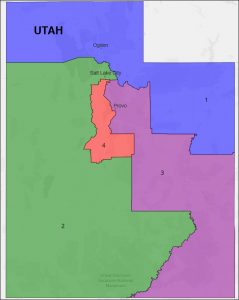By Jim Ellis
Dec. 10, 2021 — Continuing our redistricting report about the 20 multi-congressional district states that have completed the re-drawing process, today, we look at the domains from Montana through West Virginia.
Montana:
The Montana Districting and Apportionment Commission for the first time had a congressional map to draw. The state rose from at-large status to gaining a new district in reapportionment due to strong population growth. Montana is the first multi-district state to ever fall into at-large status, as it did in the 1990 census, and then regain a second district.
Though more Democratic maps were filed for commission consideration, the main Republican offered map was adopted. One of the Democratic commissioners voted for the plan, which allowed the GOP version to prevail. Still, all of the maps created an east and west seat, with the new western seat, labeled District 1, being the more competitive.
At-large Rep. Matt Rosendale (R-Glendive) will run in the safely Republican eastern District 2, while former congressman and ex-US Interior Secretary Ryan Zinke appears to be the early leader in the western district both in the Republican primary and general election. While relatively competitive, the 1st District will clearly nominate a Republican who will be the general election favorite.
Nebraska:
The unicameral legislature and Gov. Pete Ricketts (R) enacted a new congressional map that should again deliver a 3R-0D delegation. Rep. Don Bacon’s (R-Papillion/Omaha) marginal 2nd District – Joe Biden carried the district by more than 22,000 votes – is strengthened for the incumbent, but it still remains a competitive congressional domain.
Nevada:
The Democratic legislature and Gov. Steve Sisolak (D) enacted a map that is designed to produce a 3D-1R map but, in attempting to maximize the Democratic stake, possibly all three of the party’s intended seats now fall into the potentially competitive realm.
In 2020, Clark County hosted two of the 53 districts nationally where the winning candidate scored less than 52 percent. In 3rd District Rep. Susie Lee’s (D-Las Vegas) case, her victory percentage was less than 49 percent. Fourth District incumbent Steven Horsford (D-Las Vegas) fared only slightly better at 50.7 percent. In order to strengthen these two districts, a large number of Democrats had to be taken from the previously safe seat of 1st District Rep. Dina Titus (D-Las Vegas).
The end result is three Democratic seats in the lower 50s. In a Republican year, and considering the GOP is beginning to score better with Hispanics who comprise more than 31 percent of the Clark County population, all three seats could conceivably host competitive challenge campaigns. Rep. Mark Amodei (R-Carson City), the lone Republican incumbent in the Nevada delegation, gets a safe northern state seat.
North Carolina:
The courts have been playing ping pong with the North Carolina map this week. A three-judge panel first issued a stay order on the Tar Heel State’s Dec. 17 candidate filing deadline pertaining to a redistricting lawsuit before the court. A day later, the full 15-member state Appellate Court overturned the panel’s ruling, and restored the original filing deadline. Just this week, the state Supreme Court quickly reinstated the candidate filing stay and ordered the March 8 primary postponed until May 17.
The North Carolina map is the national Republicans’ best to date. If it survives the legal challenge, the GOP could net as many as three seats in the delegation. It appears that five seats will be open, with Reps. G.K. Butterfield (D-Wilson) and David Price (D-Chapel Hill) retiring, Rep. Ted Budd (R-Advance) running for Senate, and with two more seats beign created through reapportionment and the map-drawing process.
Under the enacted map, Rep. Kathy Manning (D-Greensboro) and Virginia Foxx (R-Banner Elk) are paired in a new 11th District, which would heavily favor the GOP nominee.
Ohio:
The legislature and Gov. Mike DeWine (R) recently approved a new congressional map that may net the Republicans a one-seat gain, or could conceivably yield the Democrats a similar outcome. Three of the state’s 15 new districts are highly competitive — Ohio lost one seat in reapportionment — with two currently in Democratic hands and one under GOP control.
Reps. Steve Chabot (R-Cincinnati), Marcy Kaptur (D-Toledo), and the open 13th District seat of Rep. Tim Ryan (D-Warren), now located on the west side of Cleveland, are all tightly constructed partisan districts. In the remaining seats, Republicans hold a significant 10-2 advantage. Retiring Rep. Anthony Gonzalez’s (R-Rocky River) 16th District has effectively been collapsed.



